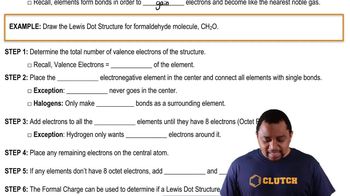A 100.0-mL buffer solution is 0.175 M in HClO and 0.150 M in NaClO. c. What is the pH after addition of 85.0 mg of NaOH?
Ch.17 - Aqueous Ionic Equilibrium
Chapter 17, Problem 51
A 350.0-mL buffer solution is 0.150 M in HF and 0.150 M in NaF. What mass of NaOH can this buffer neutralize before the pH rises above 4.00? If the same volume of the buffer were 0.350 M in HF and 0.350 M in NaF, what mass of NaOH could be handled before the pH rises above 4.00?
 Verified step by step guidance
Verified step by step guidance1
Identify the components of the buffer solution: HF (weak acid) and NaF (its conjugate base).
Use the Henderson-Hasselbalch equation to find the pH of the buffer: \( \text{pH} = \text{pK}_a + \log \left( \frac{[\text{A}^-]}{[\text{HA}]} \right) \), where \( \text{pK}_a \) is the negative logarithm of the acid dissociation constant of HF.
Determine the amount of NaOH that can be added before the pH exceeds 4.00 by rearranging the Henderson-Hasselbalch equation to solve for the ratio \( \frac{[\text{A}^-]}{[\text{HA}]} \) when \( \text{pH} = 4.00 \).
Calculate the moles of HF and NaF initially present in the buffer using their concentrations and the volume of the solution.
For each buffer concentration scenario (0.150 M and 0.350 M), calculate the moles of NaOH that can be added by using the change in moles of HF and NaF required to reach the pH of 4.00, and convert this to mass using the molar mass of NaOH.
Key Concepts
Here are the essential concepts you must grasp in order to answer the question correctly.
Buffer Solutions
A buffer solution is a system that resists changes in pH upon the addition of small amounts of acid or base. It typically consists of a weak acid and its conjugate base, which work together to neutralize added acids or bases. In this case, HF (a weak acid) and NaF (its conjugate base) form a buffer that can maintain a stable pH when NaOH (a strong base) is added.
Recommended video:
Guided course

Buffer Solutions
Henderson-Hasselbalch Equation
The Henderson-Hasselbalch equation relates the pH of a buffer solution to the concentration of its acid and conjugate base. It is expressed as pH = pKa + log([A-]/[HA]), where [A-] is the concentration of the conjugate base and [HA] is the concentration of the weak acid. This equation is essential for determining how much strong base can be added to a buffer before the pH exceeds a certain value, such as 4.00 in this question.
Recommended video:
Guided course

Henderson-Hasselbalch Equation
Neutralization Reaction
A neutralization reaction occurs when an acid reacts with a base to produce water and a salt, effectively reducing the pH of the solution. In the context of the buffer, adding NaOH will neutralize some of the HF, converting it to F-. The amount of NaOH that can be added before the pH rises above a specified level depends on the initial concentrations of HF and NaF, as well as the buffer capacity, which is determined by the amounts of the acid and base present.
Recommended video:
Guided course

Lewis Dot Structures: Neutral Compounds
Related Practice
Textbook Question
Textbook Question
For each solution, calculate the initial and final pH after adding 0.010 mol of NaOH. a. 250.0 mL of pure water b. 250.0 mL of a buffer solution that is 0.195 M in HCHO2 and 0.275 M in KCHO2 c. 250.0 mL of a buffer solution that is 0.255 M in CH3CH2NH2 and 0.235 M in CH3CH2NH3Cl
Textbook Question
A 100.0-mL buffer solution is 0.100 M in NH3 and 0.125 M in NH4Br. What mass of HCl can this buffer neutralize before the pH falls below 9.00?
2
views
Textbook Question
Determine whether or not the mixing of each pair of solutions results in a buffer. a. 100.0 mL of 0.10 M NH3; 100.0 mL of 0.15 M NH4Cl
Textbook Question
Determine whether or not the mixing of each pair of solutions results in a buffer. b. 50.0 mL of 0.10 M HCl; 35.0 mL of 0.150 M NaOH
